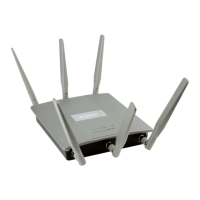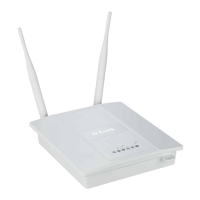27D-Link DAP-2695 User Manual
Web User Interface
Transmit Power:
WMM (Wi-Fi Multimedia):
Ack Time Out
(2.4 GHZ, 64~200):
Short GI:
IGMP Snooping:
Multicast Rate :
Maximum Multicast
Bandwidth :
Multicast Bandwidth
Control :
HT20/40 Coexistence :
Transfer DHCP Oer to
Unicast :
STP Status:
This setting determines the power level of the wireless transmission. Transmitting power can be adjusted to eliminate the
overlapping of wireless area coverage between two access points where interference is a major concern. For example, if wireless
coverage is intended for half of the area, then select 50% as the option. Use the drop-down menu to select 100%, 50%, 25%, or
12.5%.
WMM stands for Wi-Fi Multimedia. Enabling this feature will improve the user experience for audio and video applications over
a Wi-Fi network.
To eectively optimize throughput over long distance links enter a value for Acknowledgement Time Out between 25 and 200
microseconds for 5 GHz or from 64 to 200 microseconds in the 2.4 GHz in the eld provided.
Select Enable or Disable. Enabling a short guard interval can increase throughput. However, be aware that it can also increase
the error rate in some installations due to increased sensitivity to radio-frequency installations.
Select Enable or Disable. Internet Group Management Protocol allows the AP to recognize IGMP queries and reports sent between
routers and an IGMP host (wireless STA). When IGMP snooping is enabled, the AP will forward multicast packets to an IGMP host
based on IGMP messages passing through the AP.
Select the multicast rate for 2.4GHz and 5GHz band.
Set the multicast packets maximum bandwidth pass through rate from the Ethernet interface to the Access Point.
Adjust the multicast packet data rate here. The multicast rate is supported in AP mode, (2.4 GHZ and 5 GHZ) and WDS
with AP mode, including Multi-SSIDs.
Enable this option to reduce interference from other wireless networks in your area. If the channel width is operating at 40MHz
and there is another wireless network’s channel over-lapping and causing interference, the Access Point will automatically change
to 20MHz.
Enable to transfer the DHCP Oer to Unicast from LAN to WLAN, suggest to enable this function if stations number is larger than 30.
Enable Spanning Tree Protocol Status to help prevent switching loops.

